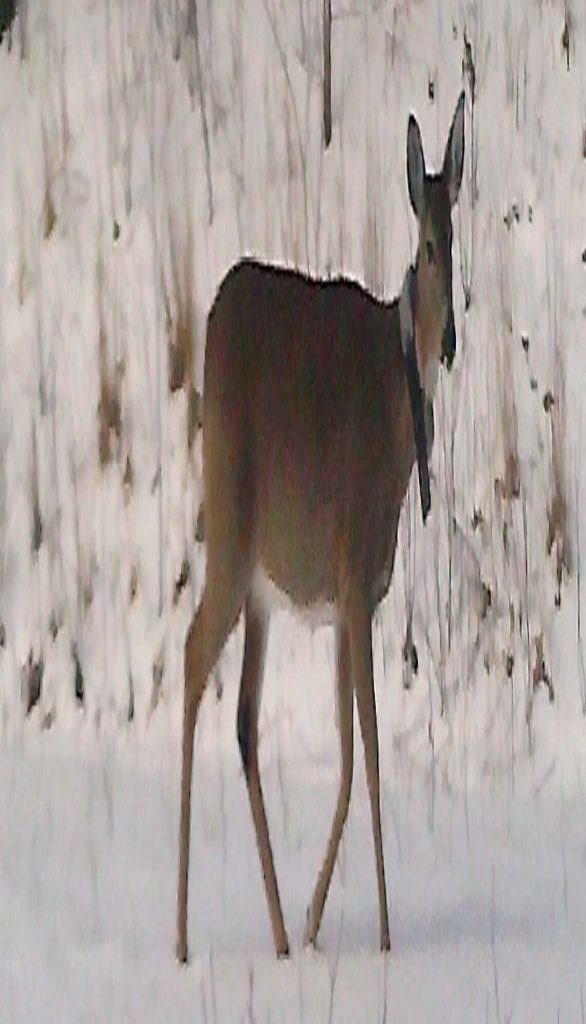Flexibility is a fabulous asset. Flexible schedules, flexible joints, flexible plastic bottles full of ketchup that don’t break when you drop them on the kitchen floor.
This elastic property allows forgiveness and responsiveness to life’s challenges. Be they an unforeseen trip to the vet, a slip on the ice, or butter fingers in the fridge.
Mother Nature sometimes employs this tactic as well.
Take populations for example. Whether a population increases, decreases, or remains stable depends on changes in survival rates and reproductive rates. Population growth is measured as the change in population size from one year to the next.
Specifically, population growth is defined as population size in year 2 (N2) divided by population size in year 1 (N1). We science geeks like to use Greek letters too. So we use λ (lambda) to represent this metric of population growth
λ = N2/N1
What does λ have to do with the Incredibles, Elastigirl, and deer? I’ll get to that.
More about λ first. If a population was 5,000 in year 1 and 5,000 in year 2, then λ = 1 and the population didn’t change (N1 = N2).
If λ is less than 1 the population is declining (N1 > N2) and if λ is greater than 1 the population is increasing (N2 > N1).
Simple stuff, but fancy symbols make it look cool.
Biologists obviously are interested in the value of λ. But more importantly, they are interested in what influences λ – changes in survival and reproductive rates.
Fawn survival rates, adult survival rates, female reproductive rates – does a small change in one cause a big change in λ?
Which of these things is most important? What causes the biggest swing in λ?
We measure the relative importance of these rates as elasticity – for example, what effect does a 1% change in these factors have on λ?
It turns out that for ungulates in general, adult female survival represents the largest elasticity in λ. So that means population growth is really sensitive to changes in adult female survival.
That doesn’t mean that fawn survival or reproductive rates aren’t important. But they aren’t as important because adult female survival absorbs most of that elasticity. That’s good news because adult female survival exhibits little annual variation over time.
And that holds for many different ungulate species.
Since we have been radio-collaring and monitoring deer in Pennsylvania since 2000, we have recorded 1,115 mortalities of adult deer (>1 year old).
Of those 1,115 mortalities, the causes were the following:
- 69% were hunter harvests,
- 11% were roadkills,
- 11% were undetermined, and
- 0.8% were killed by predators.
The remaining 8.2% were from various causes (e.g., starvation, disease, etc.).
Even in our most remote forest region (WMU 2G in northcentral Pennsylvania), with some of our highest predator densities, the pattern is the same. Of 237 mortalities:
- 68% were hunter harvests,
- 9% were roadkills,
- 14% were undetermined, and
- 2.5% were killed by predators.
So the primary cause of death for adult deer is predation! But it’s human predation that takes the bulk of the deer that die – either through hunter harvest or road-killed deer.
That’s even better news because state wildlife agencies can manage the largest cause of adult mortality – the pliable ElastiDoe!
-Duane Diefenbach
Previous articles in this series:
Fawns, Predators, and Deer Populations-what’s the bottom line on fawn survival?
Bunches, Heaps, and Gobs of Fawns
Land of the Living
A Million Ways to Die
Don’t Run that Way
Who’s Eating Bambi? – North America Edition
All Good Things
Time May Change Me
Living Outside of the Box
Next article in this series:
If you would like to receive email alerts of new blog posts, subscribe here.
And Follow us on Twitter @WTDresearch
